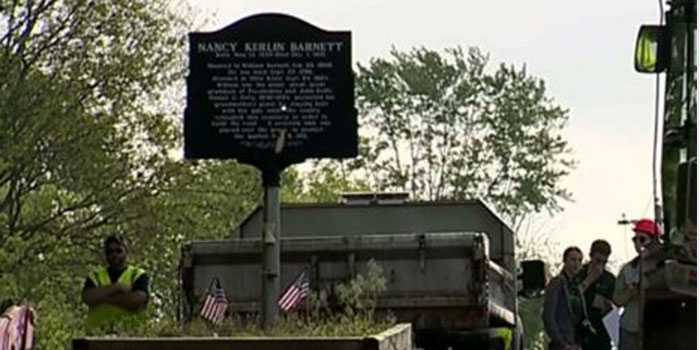Historic ‘Grave In The Middle Of The Road’ Being Excavated In Johnson County

JOHNSON COUNTY — The remains of a woman who was married to the great-great-great grandson of Pocahontas are being exhumed from a grave in the middle of a road in Johnson County this week.
The remains of Nancy Kerlin Barnett are being gently excavated from the grave she has occupied since 1831.
“Nancy Kerlin Barnett was one of the early pioneers of Johnson County, moving here in 1821,” said Johnson County Museum of History Director, David Pfeiffer. “That’s probably even before we were officially a county. So that’s just a fascinating part of our history that she was one of those early ones here.”
Nancy was married to William Barnett, who is said to be the great-great-great grandson of Pocahontas and and John Rolfe.
When Nancy passed away in 1831, her family buried her in one of her favorite spots, overlooking Sugar Creek in Johnson County. In 1905, when the county wanted to build a road through the area, Nancy’s descendants refused to let them move Nancy’s grave.
“As the story has it, since this was her wish, her family guarded her grave, supposedly with a shotgun,” Pfeiffer said. “And if I were a road worker, I wouldn’t want to go across them either.”
As a result, the county build the road around Nancy’s grave. Even today, County Road 400 splits to make room for the grave, which sits in the median.
Recently, erosion and several vehicle strikes have disturbed the shallow grave. Nancy’s body is actually buried in a mound which is above ground level. County officials have taken reports of human remains being exposed at the site.
This week, scientists, historians and county highway workers began the task of removing Nancy Barnett’s remains from the grave.
“We’re going to remove those remains temporarily, they’re going to lower the grave itself, so it’s not above grade so it’s not being struck anymore,” said UIndy Professor of Anthropology, Dr. Chris Schmidt. “And then those remains are going right back into the same land they were in before.”
Schmidt and his anthropology students will examine the remains for several weeks while county highway crews work to widen C.R. 400. Schmidt says they hope to learn more about Nancy Barnett’s life by examining her skeleton. But DNA testing, and a search for her cause of death will not be part of their work.
“You can tell if a person had a lot of disease, or no disease. You can tell if a person is surprisingly tall, or surprisingly short,” Schmidt said. “You really get a window into what life was like 200 years ago. And yes, there’s a lot of history books, but it’s also amazing to see what this individual did. Not just in general, but what this individual did.”
Although any type of coffin from 1831 would be gone by now, Schmidt says he would expect Nancy Barnett’s skeleton to be largely intact. The remains will be placed inside a new casket and lowered into the deeper grave after the roadwork is finished.
Two people who said they were descendants of Nancy and William Barnett were at the grave site when excavation got underway Monday. They each said they had initial reservations about the project. But those concerns were somewhat relieved when they were reassured that the grave will remain in the same place in the middle of C.R. 400.
“And as far as we know, it’s the only grave in the middle of a road in Indiana,” Pfeiffer said.
The excavation of Nancy Barnett’s grave is expected to last one week. The roadwork to widen C.R. 400 is expected to last several more weeks, although the time frame is uncertain depending on weather conditions. A rededication ceremony is planned once the work is finished and the remains are lowered into the deepened grave.
Source: Fox 59
